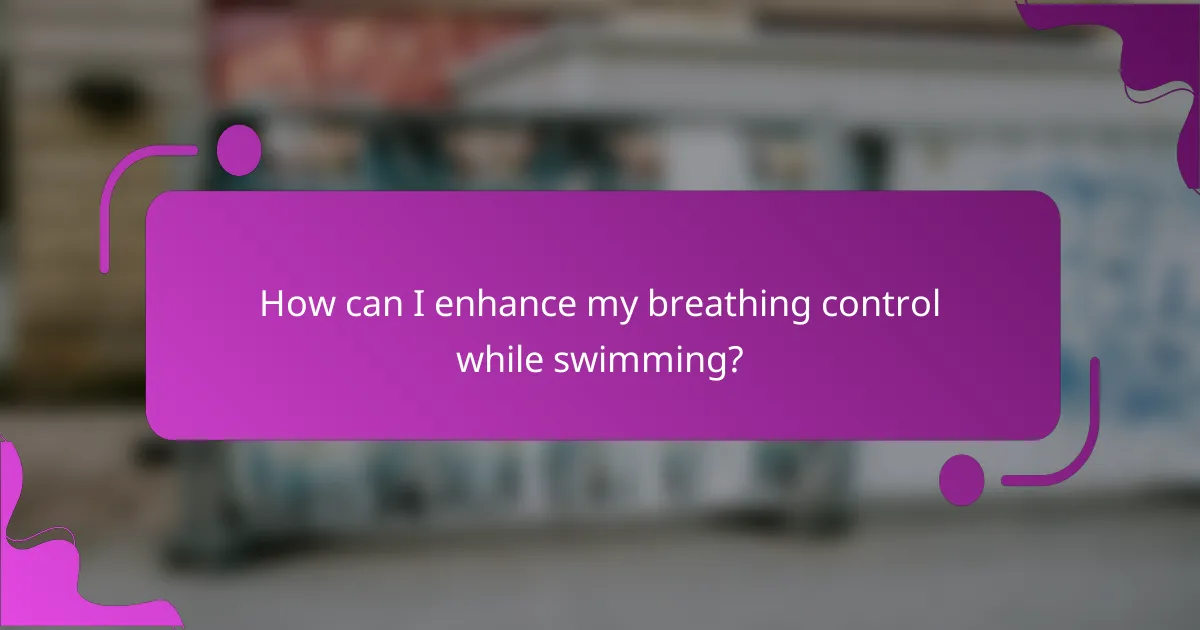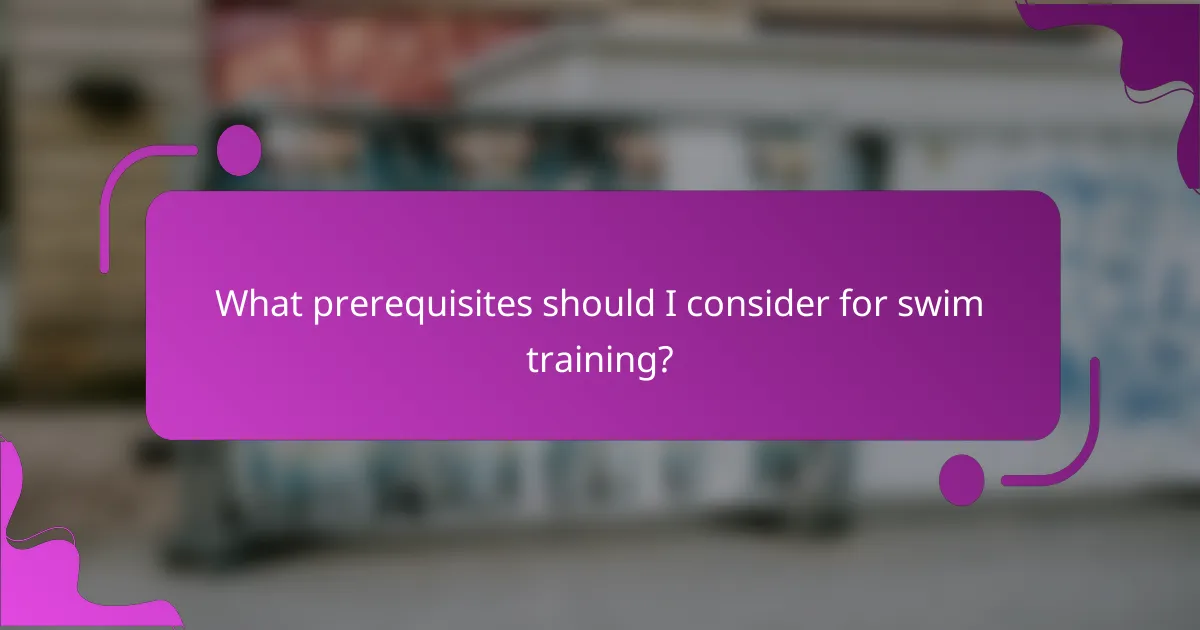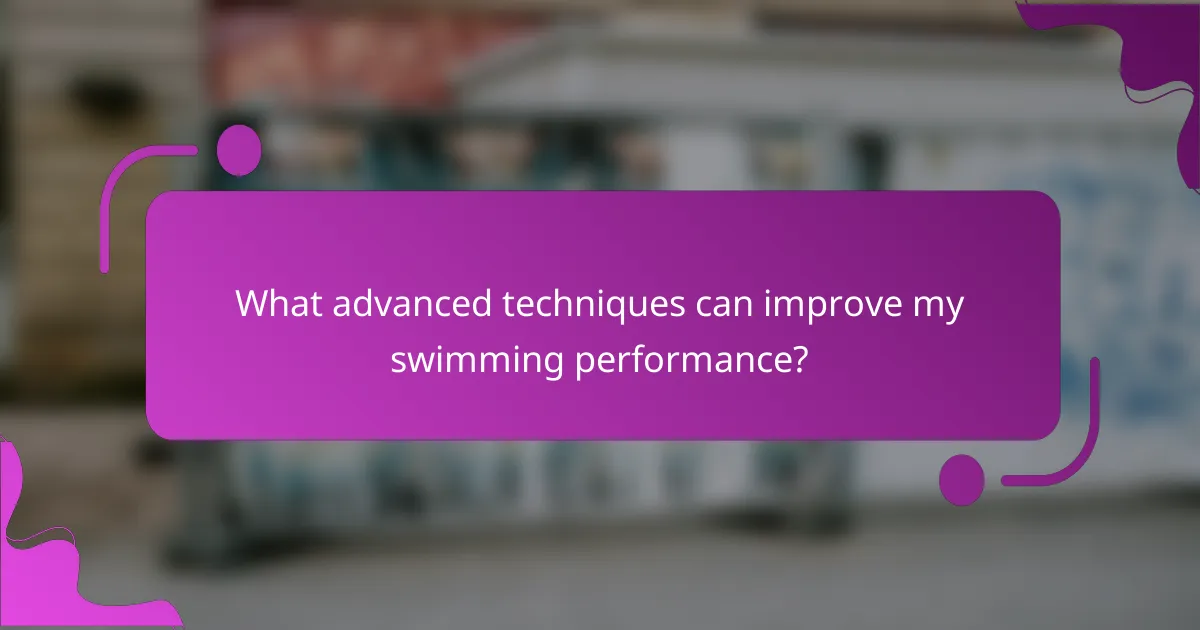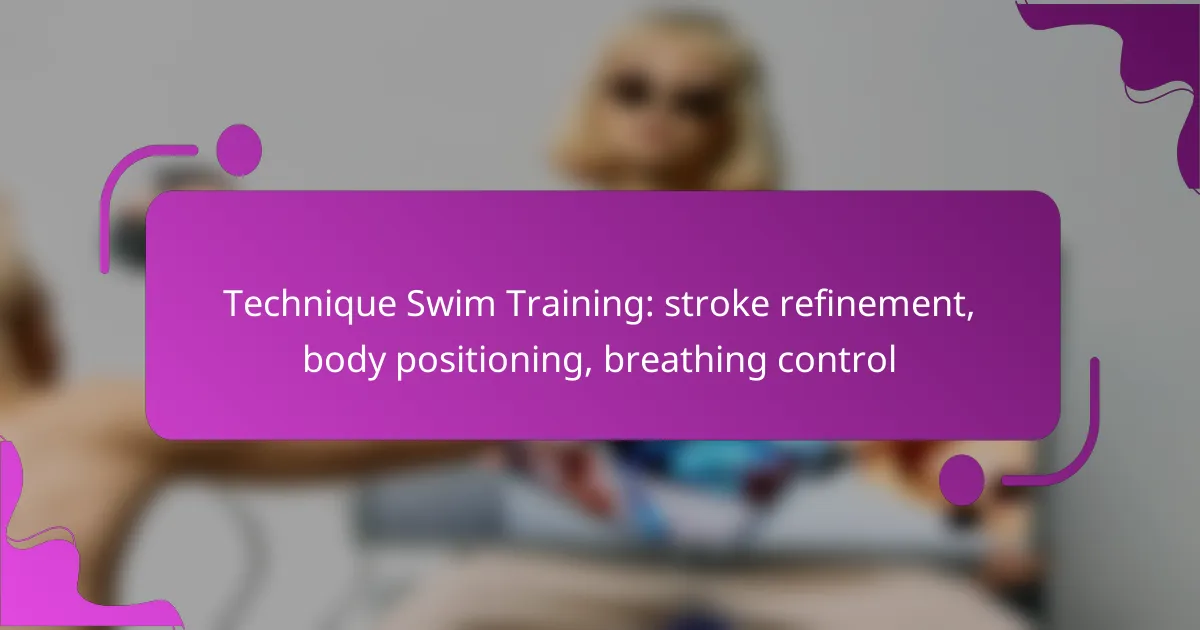Technique swim training is essential for refining your stroke, improving body positioning, and mastering breathing control. By incorporating methods such as one-on-one coaching and video analysis, swimmers can enhance their performance and efficiency in the water. Focusing on streamlined posture and effective breathing techniques will lead to significant improvements in your overall swimming capabilities.

How can I improve my swimming stroke in Sydney?
Improving your swimming stroke in Sydney involves focused training techniques such as one-on-one coaching, video analysis, and group workshops. These methods help refine your body positioning, enhance breathing control, and ultimately boost your overall performance in the water.
One-on-one coaching sessions
One-on-one coaching sessions provide personalized feedback tailored to your specific needs. A coach can assess your stroke technique, body positioning, and breathing patterns, offering targeted drills to correct any inefficiencies.
In Sydney, many coaches are available for private lessons, often at local pools. Sessions typically last around 30 to 60 minutes, allowing ample time for practice and adjustments.
When selecting a coach, consider their experience and qualifications. Look for coaches who have a background in competitive swimming or coaching certifications to ensure effective guidance.
Video analysis for stroke correction
Video analysis is an effective tool for stroke correction, allowing swimmers to visually identify areas for improvement. By recording your swimming from different angles, you can see your body positioning and stroke mechanics in real-time.
In Sydney, many swim schools offer video analysis as part of their training programs. This method can reveal subtle flaws that may not be noticeable during practice, enabling you to make precise adjustments.
To maximize the benefits of video analysis, review the footage with a coach who can provide insights on technique and suggest specific drills to address identified issues.
Group technique workshops
Group technique workshops are a great way to improve your swimming stroke while benefiting from a collaborative environment. These workshops typically focus on specific aspects of swimming, such as stroke refinement and breathing control.
In Sydney, many swim clubs and fitness centers host these workshops, which often last a few hours and include both instruction and practice time. Participating in a group can also motivate you and provide valuable peer feedback.
When attending a workshop, come prepared with questions and be open to feedback. Engaging with fellow swimmers can enhance your learning experience and help you discover new techniques.

What are effective body positioning techniques for swimmers?
Effective body positioning techniques for swimmers focus on maintaining a streamlined posture to reduce drag and enhance propulsion. Key aspects include body alignment, hip rotation, and overall balance in the water.
Streamlined body alignment
Streamlined body alignment is crucial for minimizing resistance while swimming. Swimmers should aim to keep their body straight from head to toe, with the head in a neutral position, looking down. This alignment helps to create a hydrodynamic profile that allows for smoother movement through the water.
To achieve optimal alignment, swimmers can practice drills such as the “superman” glide, where they extend their arms forward and kick gently, focusing on keeping the body flat and straight. Common pitfalls include lifting the head too high or allowing the hips to sink, which can increase drag.
Hip rotation for freestyle
Hip rotation is essential for an efficient freestyle stroke, as it allows for better reach and power during each stroke. Swimmers should aim for a rotation of about 30 to 45 degrees from the hips, which helps engage the core and facilitates a longer stroke.
To practice hip rotation, swimmers can incorporate drills like side kicking, where they kick on their side with one arm extended and the other resting along the body. This drill encourages proper rotation while maintaining balance. Avoid over-rotating or under-rotating, as both can disrupt stroke efficiency and lead to fatigue. Regularly checking body position during practice can help maintain the right alignment and rotation.

How can I enhance my breathing control while swimming?
Enhancing breathing control while swimming involves mastering timing and technique to ensure efficient oxygen intake without disrupting your stroke. Focus on integrating breathing into your rhythm and maintaining proper body positioning to optimize performance.
Breathing drills for rhythm
Breathing drills help swimmers develop a consistent rhythm, which is crucial for maintaining speed and efficiency. One effective drill is the “3-3-3” drill, where you swim three strokes with your right arm, three with your left, and then three full strokes, focusing on breathing every three strokes. This promotes a natural breathing pattern while reinforcing stroke mechanics.
Another useful drill is the “bubble, breathe, and swim” method. Start by floating on your stomach, blowing bubbles into the water, then practice turning your head to the side to breathe while maintaining a streamlined position. This drill helps swimmers become comfortable with the timing of their breaths.
Side breathing techniques
Side breathing is essential for freestyle swimming, allowing for continuous movement without significant disruption. To practice, ensure your head is aligned with your spine and rotate your body slightly as you turn your head to breathe. This minimizes drag and maintains speed.
A common mistake is lifting the head too high, which can lead to poor body positioning. Instead, aim to keep your mouth just above the water’s surface. Regular practice of side breathing will improve your overall comfort and efficiency in the water.

What prerequisites should I consider for swim training?
Before starting swim training, it’s essential to evaluate your current swimming skills and overall fitness level. These factors will help tailor your training program to improve stroke refinement, body positioning, and breathing control effectively.
Current swimming skill level
Your current swimming skill level is crucial in determining the appropriate training approach. Beginners may focus on basic techniques such as floating and kicking, while intermediate and advanced swimmers can refine their strokes and improve efficiency. Assess your comfort in the water and ability to perform different strokes to identify areas for improvement.
Consider taking a skills assessment with a coach or instructor who can provide feedback on your technique. This evaluation can highlight specific strengths and weaknesses, allowing you to set realistic goals for your training.
Fitness assessment
A fitness assessment is vital to ensure that your body is prepared for swim training. Evaluating your cardiovascular endurance, strength, and flexibility will help you understand your physical capabilities and limitations. You can perform simple tests, such as timed swims or dryland exercises, to gauge your fitness level.
Incorporate strength training and flexibility exercises into your routine to support swim training. Focus on core strength, shoulder stability, and leg power, as these are essential for effective swimming. Regularly reassess your fitness to track progress and adjust your training plan as needed.

What are the benefits of stroke refinement?
Stroke refinement enhances a swimmer’s technique, leading to improved performance and overall efficiency in the water. By focusing on specific elements of the stroke, swimmers can achieve better speed and reduce fatigue during training and competition.
Increased speed and efficiency
Improving stroke technique directly correlates with increased speed and efficiency in the water. When swimmers refine their strokes, they minimize drag and maximize propulsion, allowing them to cover distances more quickly with less effort.
Key aspects to consider include body positioning, arm movement, and kick technique. For example, a streamlined body position reduces resistance, while an effective kick can enhance forward momentum. Swimmers should aim for a smooth, continuous motion to maintain speed.
Reduced risk of injury
Stroke refinement plays a crucial role in reducing the risk of injury among swimmers. Proper technique helps to distribute forces evenly across the body, minimizing strain on muscles and joints. This is particularly important for common injuries like shoulder impingement or knee pain.
Swimmers should focus on maintaining correct body alignment and using appropriate muscle groups during strokes. Regular technique assessments and drills can help identify and correct flaws that may lead to injury. Incorporating strength training and flexibility exercises can further support injury prevention.

How do local swim clubs in Australia support technique training?
Local swim clubs in Australia play a crucial role in enhancing swimmers’ technique through structured training programs and expert guidance. They provide access to resources that help refine stroke mechanics, body positioning, and breathing control, essential for competitive swimming.
Access to experienced coaches
Experienced coaches at swim clubs are vital for effective technique training. They offer personalized feedback and tailored drills that focus on individual swimmer needs, helping to correct form and improve efficiency in the water. Coaches often have backgrounds in competitive swimming and understand the nuances of stroke refinement.
Many clubs in Australia employ coaches who are certified by recognized swimming organizations, ensuring that swimmers receive high-quality instruction. This access to expertise can significantly accelerate a swimmer’s progress, particularly for those competing at higher levels.
Regular technique-focused practices
Regular practices dedicated to technique refinement are a hallmark of local swim clubs. These sessions often emphasize specific aspects of swimming, such as body positioning and breathing control, allowing swimmers to concentrate on improving their skills systematically. Clubs typically schedule these practices multiple times a week, providing ample opportunities for development.
During technique-focused sessions, swimmers engage in drills that isolate particular strokes or movements, which helps in mastering the fundamentals. Clubs may also incorporate video analysis, enabling swimmers to see their performance and make necessary adjustments in real-time.

What advanced techniques can improve my swimming performance?
Advanced techniques such as underwater dolphin kicks and advanced flip turns can significantly enhance your swimming performance by increasing speed and efficiency. Mastering these skills allows swimmers to maintain momentum and reduce energy expenditure during races.
Underwater dolphin kicks
Underwater dolphin kicks are a powerful technique that can propel swimmers forward effectively while minimizing drag. This technique involves a fluid, wave-like motion initiated from the chest, allowing for a streamlined position that conserves energy.
To execute this skill, focus on keeping your body aligned and your head down, using your core and hips to drive the motion. Practice maintaining a consistent rhythm with your kicks, as this can help you cover more distance with less effort.
A common pitfall is overexerting the legs, which can lead to fatigue. Instead, aim for a smooth, continuous motion that utilizes your entire body. Regular practice in a pool with a depth of at least 2 meters is recommended to maximize effectiveness.
Advanced flip turns
Advanced flip turns can significantly reduce transition time during competitive swimming by allowing swimmers to maintain speed and streamline upon turning. This technique involves a quick somersault at the wall, followed by a powerful push-off to re-enter the water efficiently.
To perfect your flip turn, focus on timing your breath and rotation. As you approach the wall, tuck your chin to your chest and initiate the flip while keeping your body compact. A strong push-off with your feet will help you maintain speed as you transition into your next lap.
Common mistakes include not tucking tightly enough or failing to streamline after the turn. To avoid these issues, practice the flip turn regularly and consider using drills that emphasize body positioning and push-off strength. Aim for a seamless transition to maximize your overall performance in races.

What emerging trends are shaping swim training techniques?
Emerging trends in swim training techniques focus on stroke refinement, body positioning, and breathing control. These trends emphasize a more personalized approach, integrating technology and biomechanics to enhance performance and efficiency in the water.
Stroke refinement
Stroke refinement involves optimizing each phase of the swimming stroke to improve speed and reduce energy expenditure. Techniques such as video analysis and underwater filming allow swimmers to visualize their strokes and make necessary adjustments. Coaches often focus on elements like hand entry, catch, and pull to enhance overall stroke mechanics.
Practicing drills that isolate specific stroke components can be beneficial. For instance, using a pull buoy can help swimmers concentrate on their arm movements without worrying about their legs. Regular feedback from coaches or training partners can also accelerate improvement.
Body positioning
Body positioning is crucial for minimizing drag and maximizing propulsion in the water. Swimmers are encouraged to maintain a streamlined position, keeping their head, hips, and feet aligned. This alignment reduces resistance and allows for more efficient movement through the water.
To improve body positioning, swimmers can incorporate exercises such as balance drills and core strengthening routines. Engaging in practices like vertical kicking can also enhance body awareness and stability. Regularly checking body alignment during training can help swimmers maintain optimal positioning.
Breathing control
Breathing control is essential for maintaining rhythm and endurance in swimming. Swimmers are taught to develop a consistent breathing pattern that complements their stroke. This includes learning to breathe bilaterally, which can improve balance and symmetry in the water.
Practicing breath control can involve drills that focus on exhaling underwater and timing breaths with strokes. Swimmers should aim to keep their head low during breathing to maintain body position. Avoiding excessive head movement can help streamline the stroke and conserve energy.
